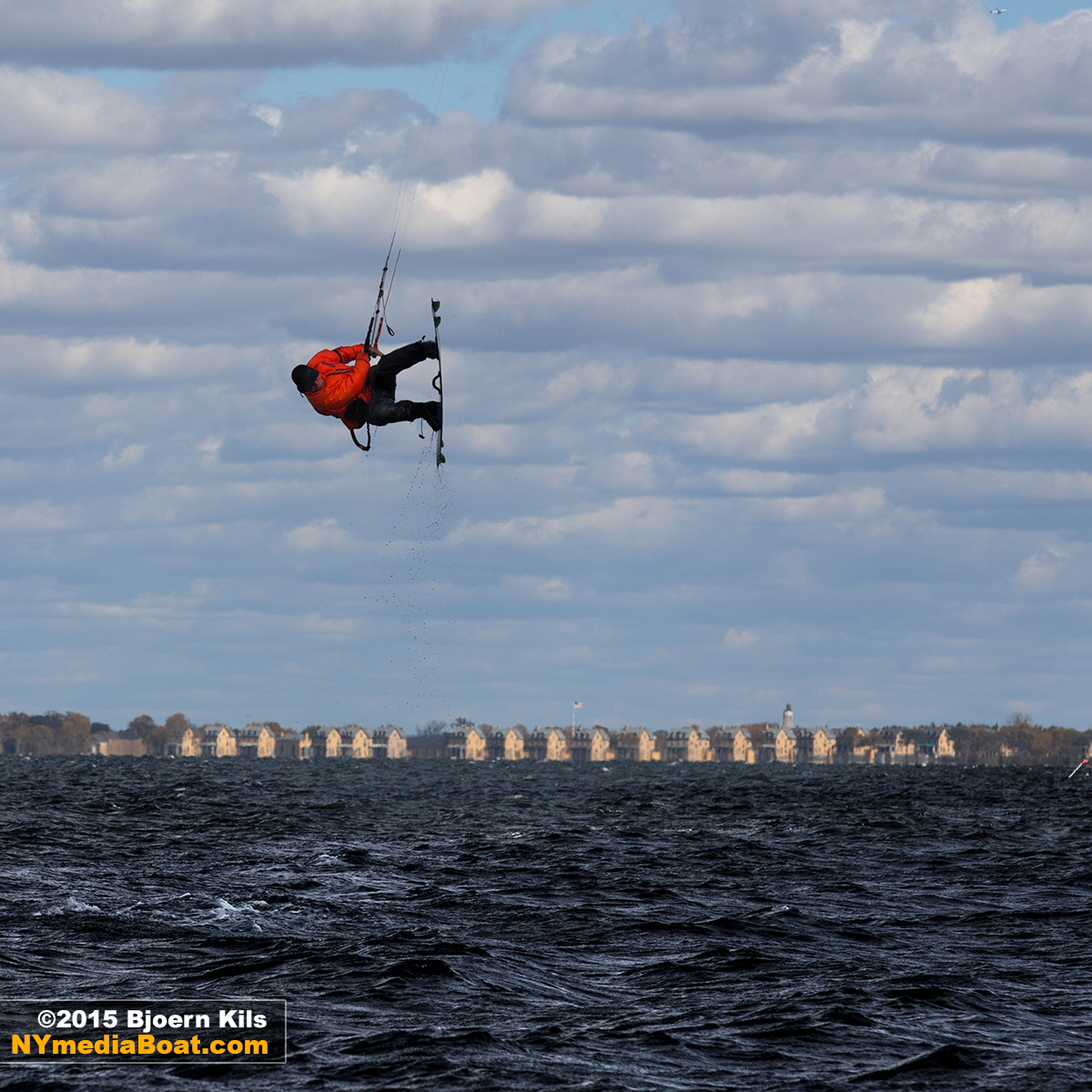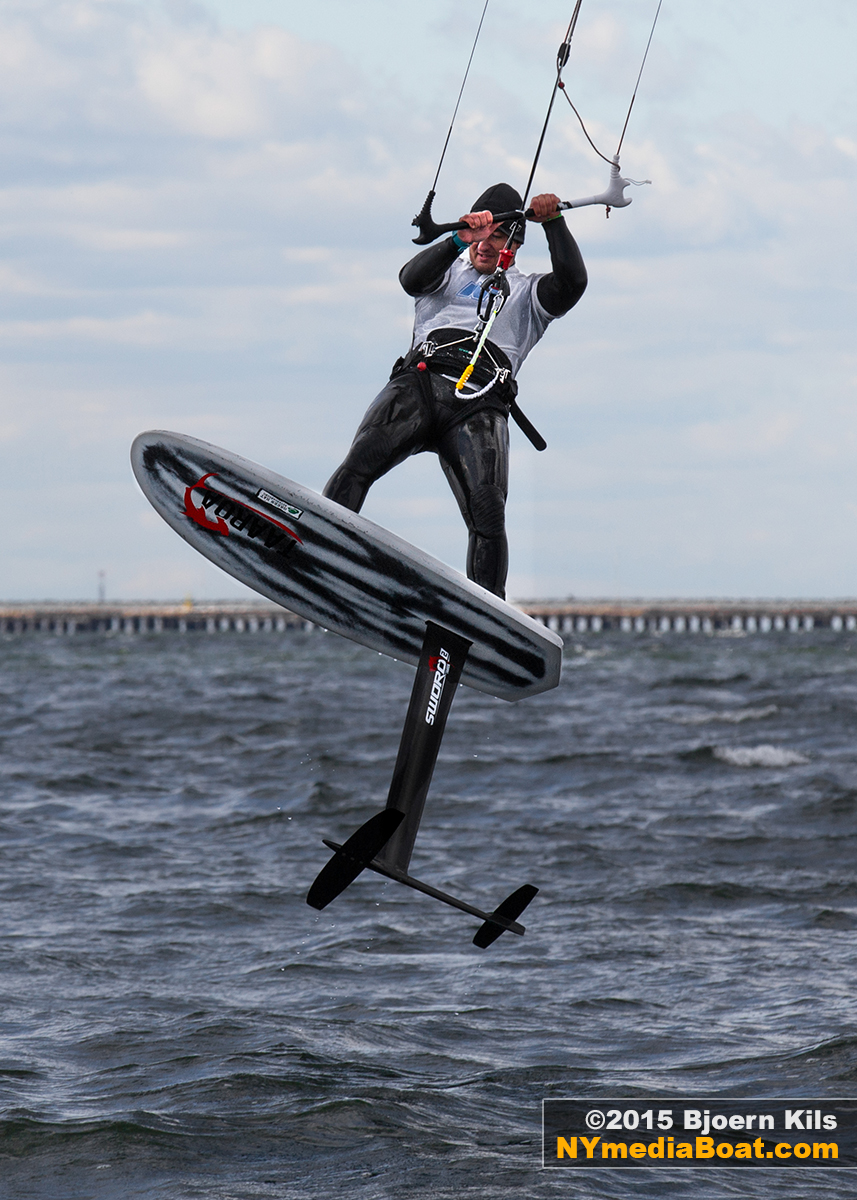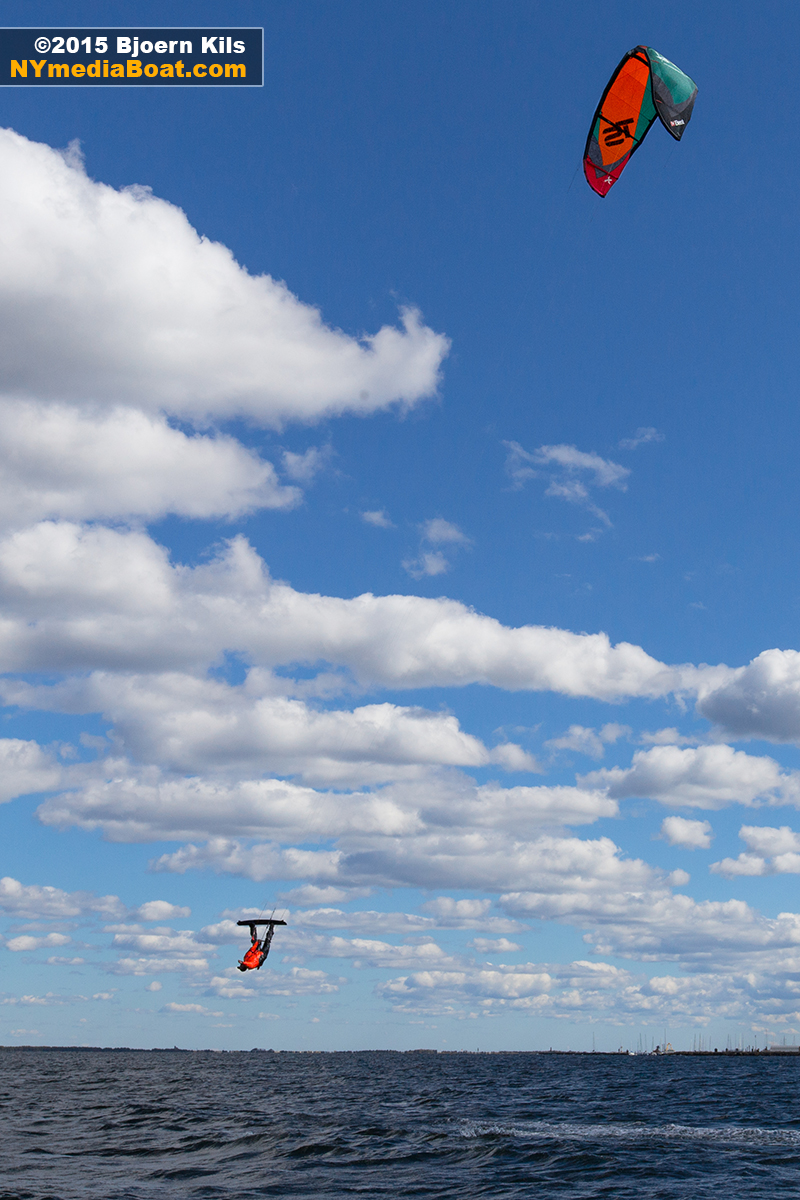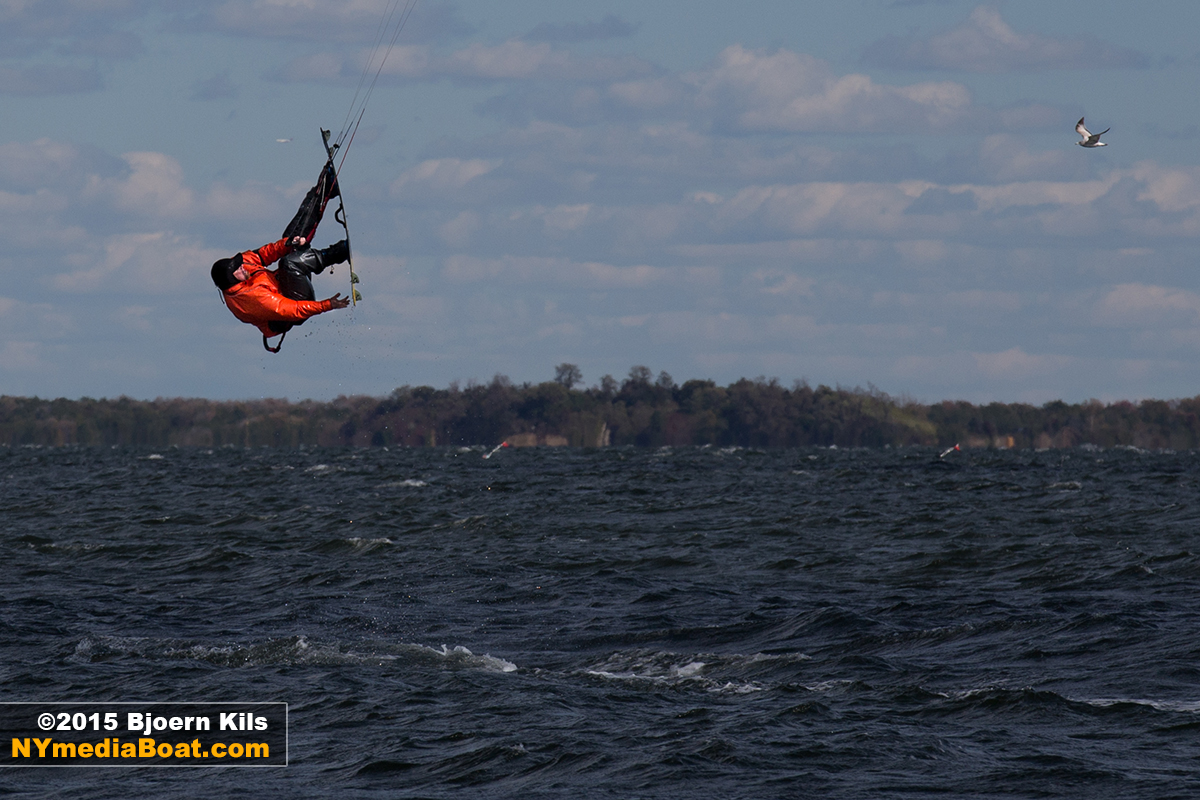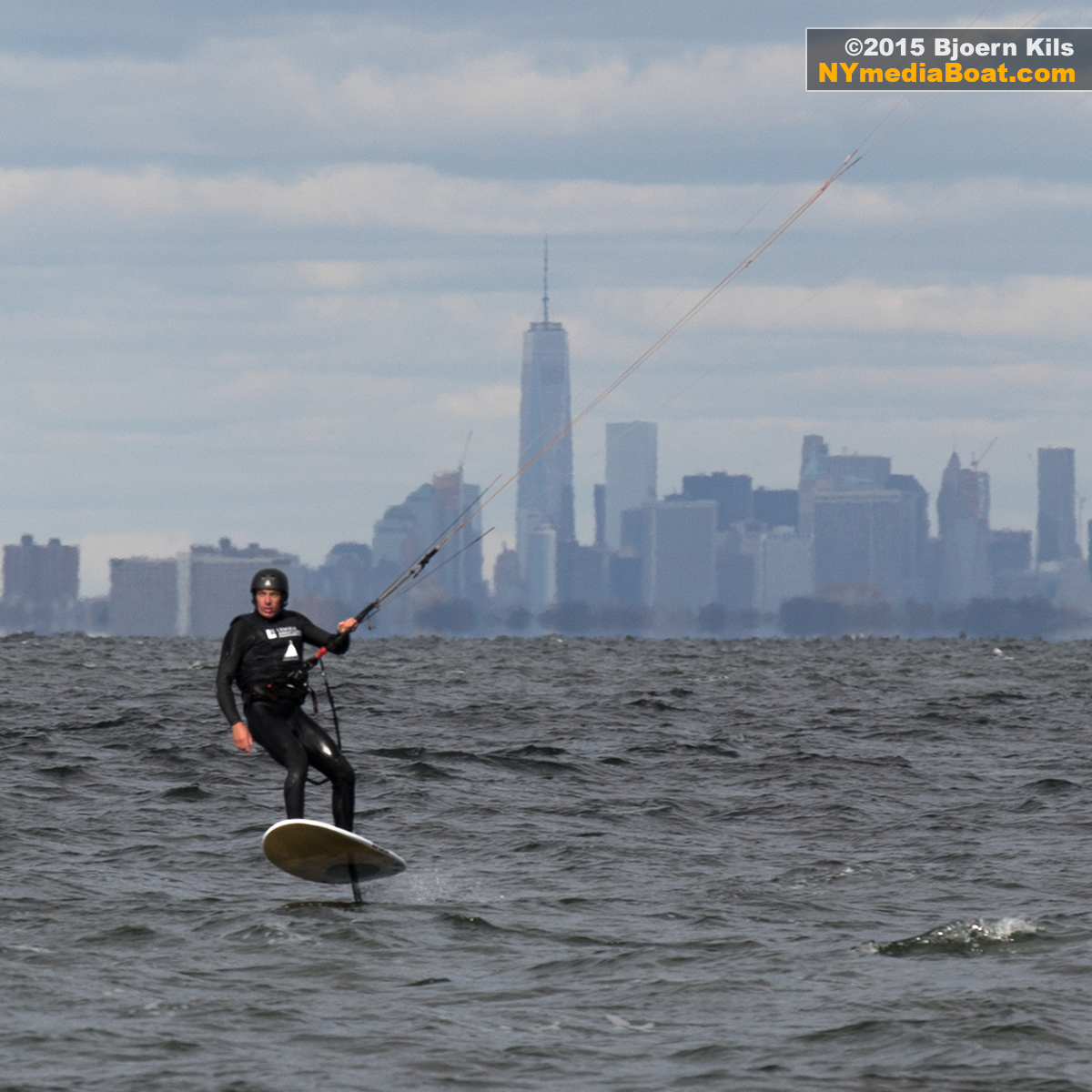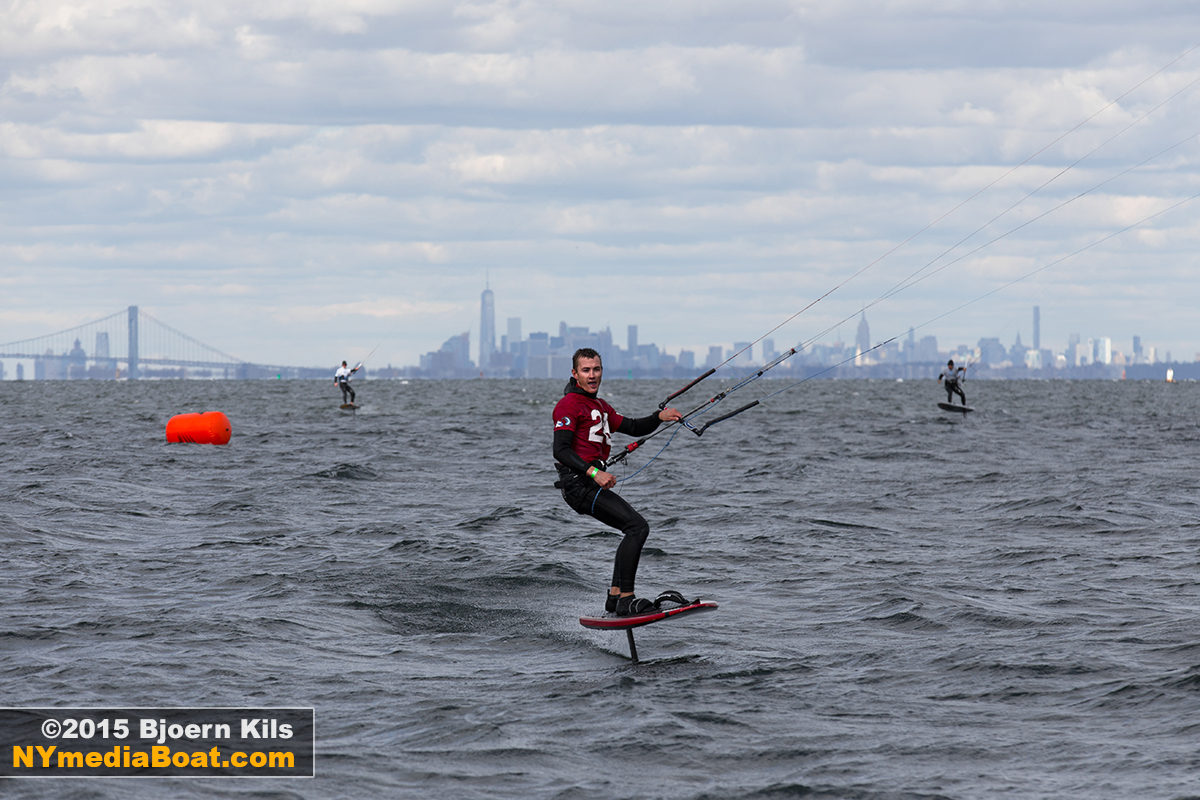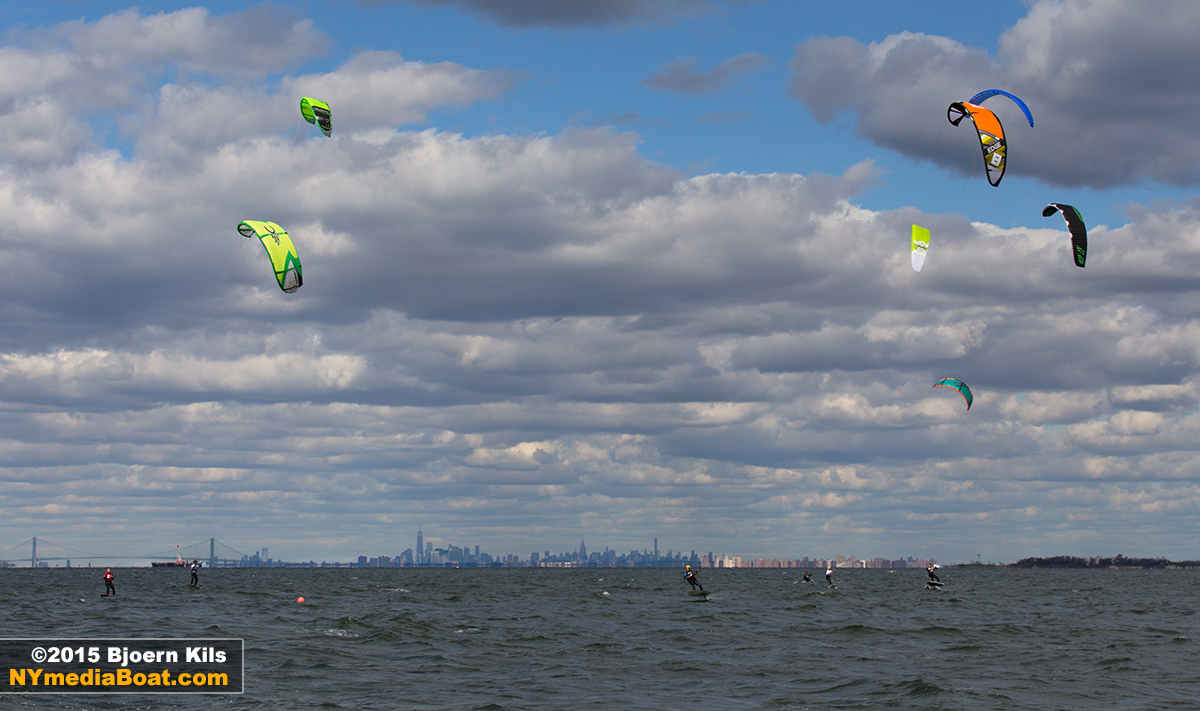Subsea Environmental Services removes old telecom cables from the ocean floor and recycles the materials.
Autumn kiteing in Atlantic Highlands
The beach at Sandy Hook Bay Catamaran Club is lined with kites and spectators, as the 2015 Foil Race & WOO Big Air Contest is happening this weekend.
Green Hat Kiteboarding put on the event calling all kiteboarders and foilboard riders from the tristate area to get together, and compete. While the foil race course was set up in deeper water about a half mile from shore, the WOO Big Air competition could be watched right off the beach. How high do they jump? On Saturday Denis Televnyy took 1st Place at 33.3 feet. Rudy Willemson claimed 2nd at 31.4 feet with 5.3 seconds airtime, closely followed by John Keenan who matched the height but landed 0.2 seconds sooner.
All height and airtime data are recorded by WOO clip-on sensors, attached to each board.
New York Media Boat stopped by for some photos:
Harbor School adds Simulator
On Wednesday the New York Harbor School christened its new Bridge Simulator at the MAST Center on Governors Island.
Students now have the opportunity to hone their ship handling and navigation skills in the same high-tech virtual environment used by many professionals. The main TRANSAS bridge simulator system is set up in a separate room where five large flat-screen monitors line the walls providing a 160-degree view of the scenario. Four additional smaller stations are set up in an adjacent room, also complete with navigation charts, engine and rudder controls, and radar screens. All five stations are networked allowing, for example, a tanker, tugs and law enforcement vessels to simultaneously function within the same scenario.
Of course I had to try this out first-hand and selected a Coast Guard small boat, as it has similar handling parameters as the boats we operate here at New York Media Boat. Running north at 30 knots from Saint George towards lower Manhattan, the harbor looked strikingly familiar. The buoys, barges and skyline all appeared in perfect detail. I threw some hard turns for good measure and the boat reacted as expected. At times I forgot that I was standing on solid ground and even started feeling a bit nauseous, as we dialed the conditions up and encountered heavy seas heading for Buttermilk Channel.
What an excellent teaching tool to add to the already impressive curriculum Captain Aaron Singh and his team have put together for their students.
The $300,000 system was donated by the American Bureau of Shipping.
Mega-crane arrives New York
After a 6,000 mile tow, the ‘Left Coast Lifter’ mega-crane arrives in New York Harbor.
The 150-foot ocean going tug ‘Lauren Foss’, powered by twin diesels producing 8,200 horsepower, completed the move of the crane after leaving San Francisco less than six weeks ago. The voyage took them down the West Coast, through the Panama Canal and up the East Coast to New York.
The convoy of tug, barge, plus support vessel ‘Iver Foss’ passed under the Verrazano Bridge around 10 am this morning and is now docked in Bayonne, NJ.
The ‘Left Coast Lifter’ was previously used on the San Francisco – Oakland Bay Bridge project and will now assist with construction on the Tappan Zee and New New York Bridge.
Custom Chart: Morris Canal
Here’s the latest intel on Morris Canal: A few months ago, Matt and I decided to create a custom map of the entrance to Liberty Landing Marina. Using the ‘Record Sonar’ Function on the Simrad Chart Plotter, we spent about 45 minutes running a north-south grid at clutch speed, followed by a few east-west passes for additional data points. The water level was three feet down from high tide.
After uploading the collected data, a contour map of the surveyed area was generated. Using Photoshop, I overlaid some additional satellite imagery plus elements from a NOAA raster chart to build the final image:
Looking at the composite, the edge of the channel is now clearly indicated by a 10-foot depth contour line, and a 20-foot deep hole is visible just north of C-dock — most likely created by the prop wash from the Little Lady when she docks at Warren Street.
Check back for part two of this project, as we plan to survey D-dock to the West End, merging all data for one complete chart.
Power Players on the Hudson
Lots happening on the Hudson during this incredible extended summer — including stunning, contrasting examples of power.
On a recent photo excursion, we spotted the tail section of a submarine, possibly on its way to the NAVY shipyard in Groton, Connecticut. Will it be a ballistic missile sub, or an attack sub? Check out this piece from Undersea Warfare on how they put one of these together.
A little less intimidating — but no less exciting — was a visit from the BayCycle Project. Founder Judah Schiller straps two pontoons to his bike, which powers a propeller and pushes him across the water. In late September, he became the first person to bike across the San Francisco Bay, and last week, the first to pedal across the Hudson — without the help of a bridge, of course.
Nearly all U.S. submarines are nuclear powered. Schiller runs on elbow (knee?) grease. Quite the contrast of high-tech versus low-tech power.
Largest Solar Boat samples Gulf Stream
NEW YORK, June 18, 2013 — I got to sail a portion of the Gulf Stream aboard VO70 ‘Maserati’ from Charleston, SC to New York last winter. We took advantage of it’s 5 mile per hour northward flow and mild temperatures. Entering the stream, foulies and boots were quickly exchanged for t-shirts and flip flops.
The Gulf Stream gyres in the North Atlantic, transporting warm nutrient rich water from the tropics along the East Coast of the U.S. towards Europe. Eventually the water cools, becomes denser, sinks and starts flowing south as part of the North Atlantic Deep Water before resurfacing off Florida.
Some speculate that without the warm influence of the Gulf Stream North America and Europe would look more like Alaska – snowy tundras and vast ice fields.
Scientist from the University of Geneva are now taking a closer look at this 60 mile wide current that extends as far as 4000ft deep.
Climatologist Martin Beniston leads the DEEPWATER EXPEDITION joining the crew of the swiss catamaran ‘MS Turanor Planet Solar’ — the largest solar powered ship in the world — on her voyage from Miami to Bergen, Norway with stops in New York, Boston, St-John’s and Reykjavik.
Beniston deems the 82ft long vessel a suitable platform for scientific sampling. No gasoline or diesel are used for propulsion and voyages are made with zero CO2 emission, eliminating potential factors of data pollution. He and his team are studying the chemical and physical composition of water masses and aerosols.
New York Media Boat spoke with Deepwater Expedition team member Dr. Bastiaan Ibelings, a professor in microbial ecology at the University of Geneva who explains the importance of phytoplankton for our oceans and climate.
The 82 foot long ‘MS Turanor PlanetSolar’ is part of a Swiss initiative to demonstrate how innovative technology can harvest renewable energy and allow clean travel. 5,500 square feet of photovoltaic cells supply power for the twin 60kW electric motors moving her averaging 5 knots.
Five World Records have been established by ‘MS Turanro PlanetSolar’ including ‘first earth circumnavigation by solar-powered boat’ and ‘fastest transatlantic crossing completely under solar power’ in 26 days. Note: French sailer Francis Joyon crossed the North Atlantic in just over 5 days powered by wind earlier this week.
Be sure to stop by the boat currently docked at North Cove Marina before she leaves on Thursday for Boston.
UPDATE 6/20/13 — PHOTO GALLERY: ‘MS Turanor PlanetSolar’ departs NY, sailing past Lower Manhattan, The Statue of Liberty, and the Brooklyn Bridge
Oligarch Eclipsed by Saudi Royals
We almost caught a glimpse of the world’s largest private yacht, but we were a day late.
Russian oligarch Roman Abramovich’s 536-foot Eclipse had just been eclipsed by a new addition to the Saudi royal family’s fleet: the 590-foot Azzam launched in Germany late last week.
Even though it was now only the world’s second largest private yacht, Eclipse was an impressive sight from just outside the 100-yard security perimeter. She needed a berth usually reserved for major cruise liners. Her main antenna, specked with half a dozen satellite domes, jutted into the skyline. Her six decks looked as if they could fold down into one giant floating Matryoshka doll.
Somewhere on board this behemoth, reportedly, there’s a submarine, a disco, a movie theater, two swimming pools, two helipads, and likely more secondary vessels than former soviet leaders.
She’s even rumored to have a missile defense system – and lasers to disable cameras.
Luckily, we couldn’t confirm either of those things.
Word is that the $1.5 billion Eclipse will be in New York until mid-April, when Abramovich’s girlfriend is expected to give birth to their child. After that, she’ll likely bebattling with the $600 million Azzam over Caribbean anchorages.
Sewage Spill Turns Attention to Hudson Plumbing
Most people are horrified by the thought of three millions of gallons of raw sewage spewing into the Hudson River.
Not Captain John Lipscomb of Hudson Riverkeeper.
“Accidents like this come and go,” he told me Friday on the phone from his boat docked on the Hudson in Ossining, N.Y., though he would have been out sampling had it not been raining. “But the chronic releases are happening all the time.”
The spill at a Westchester water treatment plant threatened to cancel Saturday’s Ironman triathlon, and environmental advocates seized the opportunity to shine a light on the regular dumping of raw sewage into New York City waterways.
“The issue for the triathletes isn’t what’s happened in Westchester, but what’s happening in the harbor,” given heavy rains on Friday, says Lipscomb, who has been Captain of Riverkeeper’s research vessel for 12 years. “From our data, we can see that chronic releases are much more significant than accidents.”
Fourteen wastewater treatment plants in New York City, and a handful in northern New Jersey, collect and filter the excess from sinks and streets alike. Much of the metropolitan area is on a combined sewer system, where the pipes that carry refuse from toilets eventually meet with those funneling away rainwater. All of it is scrubbed before being discharged back into local waterways.
Normally, the system works fine, Lipscomb says, and major accidents like the Westchester spill are rare – although an accident at a plant in Harlem poured hundreds of millions of gallons of untreated sewage into the Hudson last summer.
But after a decent rain, the combined sewer system can get overwhelmed, opening valves that send a mix of sewer and rain runoff sloshing into natural waterways.
Engineers say it’s the more palatable alternative to having raw sewage bubble up in residents’ toilets.
Every year, about 28 billion gallons of this “grey” water flow from 460 outfall sites around the city, with an additional 23 billion gallons from more than 200 sites in New Jersey, according to estimates from the Environmental Protection Agency.
Not all of that is concentrated sewage. Since it’s diluted by rainwater, about 20% of the mix comes from household drains, Lipscomb says. Still, that amounts to hundreds of millions of gallons of straight sewage leaking into local waters during each of the the Hudson River area’s average 50 storm events per year.
Riverkeeper has been detecting these discharges during monthly sampling. Below deck in their research vessel is an oven-sized incubator that reveals within 24 hours the level of Enterococcus in water samples.
Few in this bacteria genus are harmful; they’re present in the guts of most species, including humans. But abnormally high levels indicate that untreated sewage has found its way into the water.
Lipscomb’s complaint is that residents have no idea when levels exceed those considered safe for recreation.
But that’s changing. On Thursday, the same day as the Westchester spill, New York Gov. Andrew Cuomo signed into law the Sewage Pollution Right to Know Act, which will require public notification of all raw sewage spills, even those permitted during normal rainfall events.
“It’s almost like a setup,” Lipscomb says. “I was out collecting samples during the event and got an email saying the governor had signed the legislation.”
He says the city has taken other steps to alleviating the problem, like building additional rain gardens and diminishing the amount of impervious surfaces to lessen the volume of water hitting the sewers. It’s less costly than revamping the wastewater treatment infrastructure, which would run a multi-billion-dollar tab.
The New Jersey Department of Environmental Protection says it, too, has been trying to find a reasonable solution to its combined sewer outfall issues. DEP spokesperson Larry Ragonese told me the agency has added more control measures, such as filters, to 83% of its outfalls, and another 13% are under construction.
Over the past decade, about a quarter of combined sewers in the state have also been tied into other systems that don’t mix sewage and rainfall, Ragonese said.
And some municipalities have been taken to task by the EPA to upgrade, including Jersey City and Perth Amboy, which will spend $52 million and $5.4 million, respectively, on updating their systems as a result of settlements with the agency.
Ragonese says the DEP expects to release an updated plan for its combined sewer permitting process within the year – something Debbie Mans, executive director of NY/NJ Baykeeper, says is a long time coming. Her group, along with the Hackensack Riverkeeper, filed suit last year against the DEP over its slow progress.
As intimidating as regular sewage spills sound, their actual health impact is much harder to pin down. Though health officials have established safe exposure limits, swimming in places exceeding those thresholds doesn’t guarantee an infection.
Nor is there any sure-fire way to trace an illness – with water-borne disease, it can be anything from an ear infection to dysentery — to a specific exposure.
“If you swim in contaminated water and get sick 24 hours later, you don’t know if it’s from your salad, the food at the deli, or your dog,” Lipscomb said. “It’s hard to source it.”
The lack of hard evidence doesn’t mean he’d take his chances. When asked if the Ironman challenge should have gone on, as it did on Saturday, Lipscomb said it probably wasn’t the best idea – but not because of the Westchester discharge.
It was Friday’s rains, he said, that would have kept him on dry land.





